For upper-limb amputees, electric options like the FISH WINCH EZ (6.4 oz) or FISH WINCH 2500 with Shimano’s Quick Fire II system offer excellent one-handed control. Consider baitcasting reels with trigger systems for single-finger operation or specialized mounting systems like the Rexfly Casting System. The Ampo Fisher I threads directly into wrist prostheses, while harness systems distribute weight across your shoulders. The right adaptive equipment turns challenging fishing situations into successful catches.
Electric Fishing Reel Options for Upper-Limb Amputees
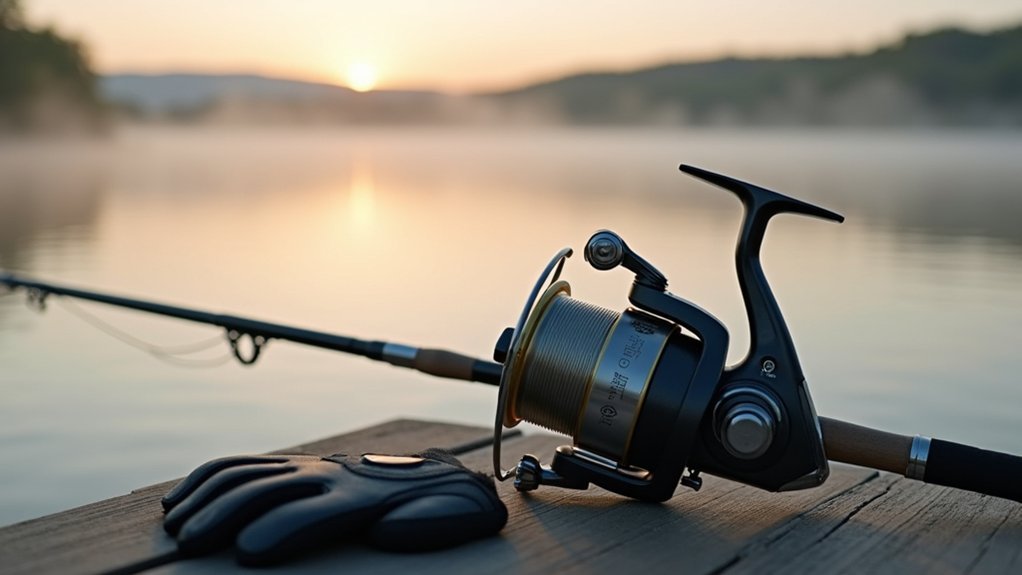
For upper-limb amputees looking to enjoy fishing independently, electric fishing reels offer game-changing solutions that combine technology with accessibility. The FISH WINCH® EZ transforms Daiwa reels into lightweight, cordless options that operate on a single 9V lithium battery and weigh just 6.4 oz. Specifically designed for individuals with limited use of one hand, this device is ideal for amputees seeking independence while fishing.
The MpowR Electric Fishing Reel provides impressive battery life, handling over 300 fish on a single charge across three days.
For saltwater enthusiasts, the 452-PTH delivers powerful performance without manual cranking.
Shakespeare’s PowerFish’n Pro features a quiet motor integrated with a spinning reel, perfect for those with limited arm function.
These reels, paired with specialized mounts like the Model FM200, allow for manual casting but motorized retrieval, making fishing accessible and enjoyable again.
Lightweight Reels With One-Handed Operation Features
Adaptability represents the cornerstone of lightweight fishing reels designed with one-handed operation in mind. You’ll find baitcasting reels offer excellent control for repeated casts, while spinning reels can be modified with clamp-on holders for single-handed use. The Freedom Fisher 25 demonstrates that adjusting to slower modes can maximize fishing success when using adaptive equipment.
| Reel Type | Key Feature | Benefit |
|---|---|---|
| Baitcasting | Trigger activation | One-handed casting control |
| Spinning | Clamp-on holders | Secures rod while operating reel |
| Electric | Dual-speed options | Adjusts to different fish fighting styles |
Look for ergonomic handles that reduce fatigue during extended fishing trips. Models like the FISH WINCH® 2500 and FreedomFISHR™ incorporate lithium-ion battery technology for powerful performance without added weight. These technological advancements guarantee you’ll experience enhanced control and versatility across various fishing environments, whether freshwater or saltwater.
Trigger-Activated Reels for Enhanced Control
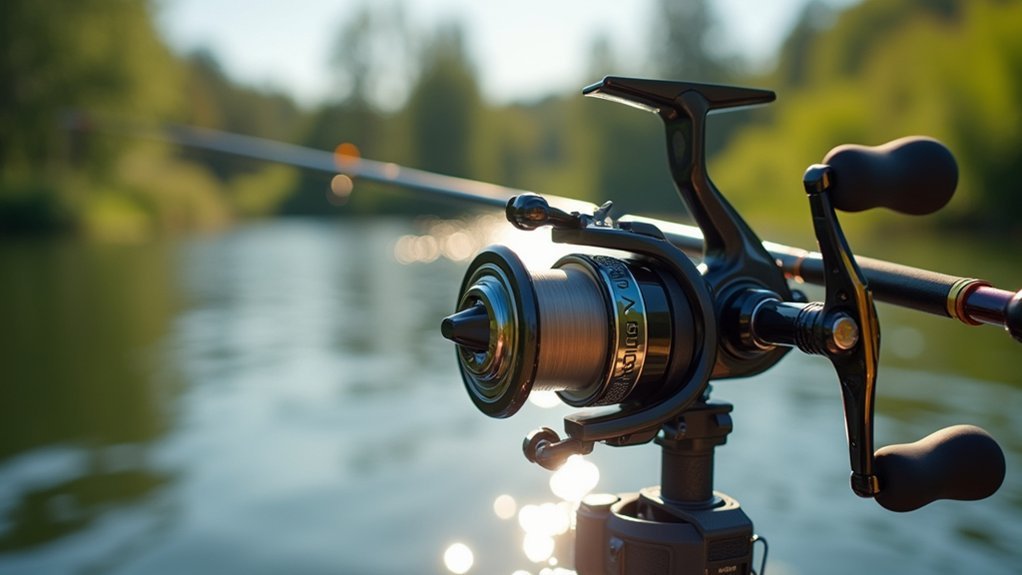
Trigger-activated reels offer remarkable control advantages for amputee anglers seeking independence on the water. These innovative devices let you manage critical functions with minimal effort, simply by pressing a trigger mechanism.
The FISH WINCH® 2500 exemplifies this technology, weighing just 14.1oz with battery included. The reel features the Shimano Quick Fire II trigger system specifically designed for one-handed casting and retrieving operations. You’ll appreciate how it handles bail opening and line retrieval automatically – perfect if you have limited dexterity or use only one hand.
These reels prioritize ergonomic design, fitting comfortably in your hand while minimizing fatigue during extended fishing sessions. Many models offer multiple retrieve speeds and work effectively in various fishing environments.
For those with severe mobility limitations, advanced options incorporate sip-and-puff technology, allowing control through breath or mouth movements, further expanding accessibility in recreational fishing.
Rod-and-Reel Harness Systems for Stability
While traditional fishing equipment presents obstacles for amputees, modern rod-and-reel harness systems offer remarkable stability and independence on the water.
These adaptive systems distribute weight across your shoulders, back, and legs, allowing you to fish confidently with one arm.
Fish with confidence and independence as weight distributes evenly across your body, not just your one available arm.
Products like the Barracuda and Rexfly Chest Harness integrate seamlessly with standard fishing equipment, featuring:
- Adjustable tension systems with quick-release mechanisms for safety
- Durable components made from powder-coated aluminum and high-impact plastic
- Wheelchair-compatible mounting options that work with spinning, casting, or fly fishing setups
You’ll appreciate how these harnesses improve control while reducing strain. The innovative Rexfly Casting System is specifically designed for one-handed use, making it ideal for amputees seeking adaptive fishing solutions.
Whether you’re a stroke survivor or have experienced an amputation, these specialized harness systems make fishing accessible again without requiring assistance.
Motorized Reels With Customizable Speed Settings
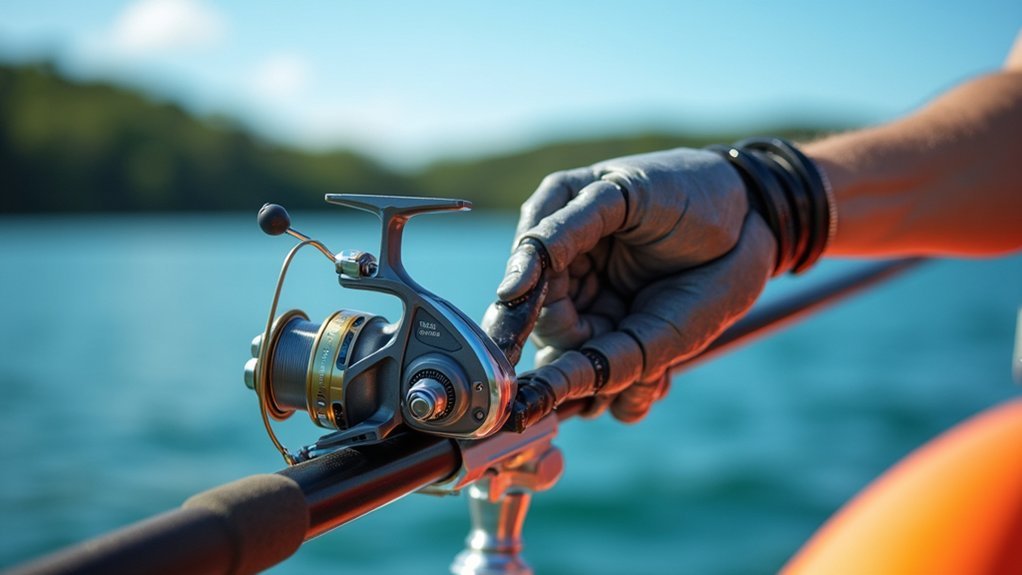
For anglers with limb differences, motorized reels represent a game-changing advancement in fishing technology. Models like the Daiwa Seaborg and Shimano BeastMaster offer variable speed settings you can adjust via dials or digital interfaces without interrupting your fishing experience.
You’ll find these reels particularly valuable for their user-friendly interfaces featuring large buttons and dials that accommodate limited dexterity. Many include remote operation capabilities compatible with assistive devices. The variable torque systems adjust to different fish species while maintaining consistent line tension.
Look for reels with multiple speed presets to support techniques like yo-yo jigging or customize your retrieval pace for specific target species.
Brands like Alutecnos offer robust, compact designs with personalization options including color-coding for easier identification—a practical feature when you’re managing multiple setups. The Lindgren Pittman electric reels are available in various colors including blue, making them easily identifiable on your gear.
Battery Life and Power Considerations for Electric Reels
Your electric reel’s battery life can make or break your fishing experience, with quality lithium-ion options offering up to 18 hours of continuous operation through 2,000 charge cycles.
You’ll appreciate how modern batteries balance power delivery with lightweight design, especially important for maintaining comfort during extended fishing sessions. For specific applications like deep dropping, selecting batteries with adequate amp-hour ratings ensures 4-6 hours of reliable performance even when fighting larger catches.
For amputees, this power-to-weight efficiency means less fatigue and more independence on the water, with various control options accommodating different physical abilities.
Battery Longevity Matters
Because electric reels represent a significant investment for amputee anglers, understanding battery performance becomes essential for uninterrupted fishing experiences.
The right battery can provide reliable power throughout your fishing trip while reducing frustration and downtime.
When selecting batteries for your adaptive electric reel, consider these critical factors:
- Battery type and capacity – LiFePO4 lithium batteries offer exceptional longevity (5-7 years or 2,000 charge cycles) and fully recharge in just 1.5 hours. Many amputee anglers prefer the lithium battery options that come standard with the Adaptive Fishing Kit.
- Maintenance requirements – Store in cool, dry places, charge every 3-4 months when not in use, and keep terminals clean to prevent corrosion.
- Usage patterns – Deep Drop Batteries (10Ah) can provide up to 18 hours of continuous power, but actual performance varies with water conditions and reel load.
Power-to-Weight Ratio Benefits
Beyond battery longevity, the power-to-weight ratio of electric reels greatly impacts an amputee angler’s fishing experience. When selecting a reel, you’ll want sufficient torque for handling large fish while minimizing strain during extended sessions.
Electric reels with adjustable gear ratios offer significant advantages—lower ratios (around 4.9:1) provide the mechanical advantage you need when fighting larger catches. Many amputee anglers find that low-speed reels deliver the necessary torque for managing heavy fish across different fishing scenarios. Look for models constructed from aluminum or graphite that balance durability with weight reduction.
The best electric reels incorporate efficient motors that conserve power while maintaining consistent retrieval speeds. Features like adjustable drag settings, voltage regulation, and automatic power cutoff functionality enhance your control while preventing unnecessary battery drain.
These design considerations guarantee you’ll have a versatile reel that adapts to various fishing conditions without causing fatigue or limiting your mobility.
Ergonomic Reel Designs for Single-Hand Use
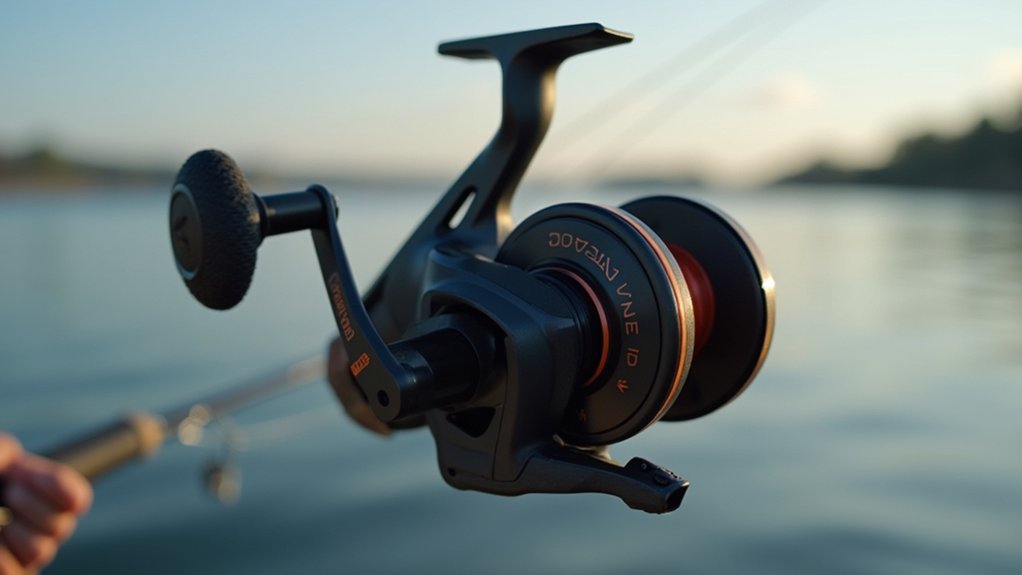
Trigger-based control systems on adaptive fishing reels let you operate casting and retrieval functions with a single finger press, eliminating the need for complex hand movements.
You’ll find thumb buttons positioned strategically on many specialized reels, allowing for quick access and natural operation while maintaining your grip on the rod.
These ergonomic designs prioritize efficiency, so you can focus on enjoying your fishing experience rather than struggling with equipment manipulation. Motorized fishing reels provide significant advantages for amputees by enabling operation with minimal physical effort.
Trigger-Based Control Systems
For individuals with limb differences or amputations, conventional fishing reels often present significant barriers that can transform an enjoyable pastime into a frustrating challenge.
Trigger-based control systems offer revolutionary solutions designed specifically for single-handed operation, making fishing accessible again.
These specialized reels feature:
- Soft-touch power buttons that enable effortless casting and retrieving without requiring complex manual manipulation
- Lightweight, compact designs (typically 6-16 ounces including battery) that reduce fatigue during extended fishing sessions
- Ambidextrous configurations that work for either left or right-handed users with customizable trigger placement aligned to natural hand positions
Electric options like the FISH WINCH® EZ adapt underspin reels with quick-release triggers, eliminating the need for two-handed operation while maintaining effectiveness for small to medium freshwater game fish. The MPowR open-faced reel provides excellent accessibility with its high-torque design capable of cranking fish up to 10 pounds without requiring complex manual dexterity.
Thumb Button Efficiency
While traditional fishing reels typically require two-handed coordination, modern ergonomic designs have revolutionized accessibility through thumb button efficiency.
You’ll find larger, textured buttons positioned for minimal thumb extension, reducing strain while maintaining control even in wet conditions.
Electric reels offer single-button operation that eliminates manual cranking, with some models compatible with assistive devices like Sip ‘N’ Puff switches.
These systems include safety cutoffs to prevent accidental activation.
Many reels now accommodate prosthetic integration with reinforced buttons designed for artificial thumbs.
Ambidextrous designs feature centrally located controls accessible from multiple hand positions, with natural thumb angles preventing discomfort.
These ergonomic improvements have proven effective, with studies showing thumb-efficient designs reduce fishing fatigue by up to 40% while increasing catch rates through better line control.
MPOWR Fishing’s 12-volt battery-powered reel was specifically designed for one-handed use, allowing anglers with disabilities to fish independently without requiring constant assistance.
Spincast vs. Spinning Reels for Different Amputation Types
Choosing between spincast and spinning reels presents unique considerations for amputees based on their specific needs and amputation type.
Upper limb amputees often benefit from spincast reels’ closed-face design and one-button operation, while those with lower limb amputations may focus more on overall weight and portability when selecting equipment.
- Upper Limb Considerations – Spincast reels offer simpler one-handed operation with less dexterity required for casting and retrieving. Many users find that multi-articulating hands provide better control when handling spinning reels that require more precise finger movements.
- Lower Limb Considerations – Either reel type works well, with personal preference and fishing technique being the deciding factors.
- Environmental Factors – Choose spinning reels for saltwater and technical fishing scenarios; spincast reels work best for freshwater and situations requiring minimal manipulation.
Your amputation type should guide your selection, but adaptive devices like the FISH WINCH EZ can make either option viable.
Mounting Systems and Adaptive Attachments
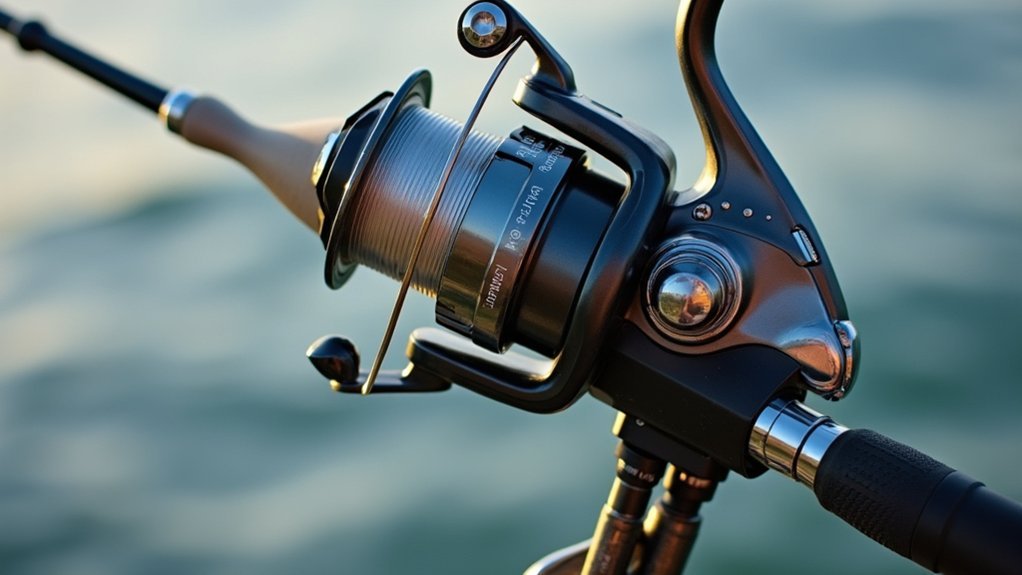
Mounting systems and adaptive attachments represent essential innovations that empower amputees to enjoy fishing independently despite physical limitations. You’ll find various options designed to complement different amputation types and mobility needs.
| Mount Type | Best For | Key Feature | Position |
|---|---|---|---|
| FM200 | Limited grip | Manual casting with secure hold | Multiple configurations |
| Ampo Fisher I | Upper-limb amputees | Threads into wrist prosthesis | Replaces terminal device |
| Harness System | Arm amputations | Distributes energy across shoulders | Front or side-mounted |
| Motorized Reel | Limited strength | Automated line retrieval | Integrates with adaptable mounts |
For wheelchair users, specialized holders attach directly to your chair, enabling one-handed operation. Forearm rollers in many designs let you operate the reel with minimal effort by simply pushing forward and back, making fishing accessible regardless of your specific mobility challenges. The Ableware Fishing Pole Holder offers a clamp-on design specifically engineered for one-handed operation and can be easily adapted to wheelchair bars.
Fighting Large Fish: Specialized Reel Drag Systems
Auto-adjusting drag mechanisms offer you hands-free tension control when fighting large fish, automatically increasing resistance as the fish pulls harder.
One-touch control systems let you adjust drag settings quickly with minimal hand movement, perfect for amputees who need efficient operation.
These specialized features transform what would be challenging battles into manageable encounters, greatly improving your chances of landing trophy catches. Remember to avoid reeling in line while the drag is releasing, as this prevents damaging line twists and tangles during your fight with larger fish.
Auto-Adjusting Drag Mechanisms
The revolutionary auto-adjusting drag mechanisms represent a game-changer for amputee anglers tackling large fish.
These systems automatically adjust line tension based on the fish’s resistance, allowing you to focus on the fight rather than constantly readjusting settings with your remaining hand.
When selecting an auto-adjusting drag system for one-handed use, consider:
- Twin-drag systems that distribute pressure evenly across both sides of the spool, providing better balance during intense fights.
- Electronic integration features that use sensors to monitor and adjust drag pressure in real-time.
- Carbon fiber drag washers that deliver consistent performance even when battling powerful saltwater species.
The heat generated by rubbing washers can significantly impact drag performance, making proper material selection especially important for amputee anglers who need reliable equipment.
Regular maintenance of these mechanisms guarantees smooth operation and longevity, making them reliable companions for your fishing adventures despite physical limitations.
One-Touch Control Systems
One-touch control systems revolutionize fishing for amputees by consolidating multiple functions into simplified operations. These intuitive systems allow you to cast, reel, and adjust settings with minimal effort, making fishing more accessible and enjoyable.
Electric reels like the MpowR and Fish Winch offer efficient one-handed operation, perfect for those with limited mobility. The Fish Winch EZ’s cordless design enhances your freedom on the water while providing powerful performance.
Complementary equipment such as harness mounts and specialized rod holders further improve accessibility, letting you focus on the joy of fishing rather than equipment limitations.
With motorized assistance, you’ll experience less fatigue during extended sessions, and soft-touch controls accommodate varying levels of dexterity. These technological advancements guarantee that physical limitations don’t prevent you from enjoying successful fishing experiences.
Maintenance Tips for Adaptive Fishing Equipment
Maintaining adaptive fishing equipment properly guarantees both longevity and reliable performance when you need it most on the water. Your adaptive reels require special attention, particularly for components that compensate for limb differences.
- Clean after every use – Rinse your reel with fresh water, especially after saltwater fishing, and dry thoroughly to prevent corrosion that could affect motorized components or ergonomic adaptations.
- Lubricate strategically – Apply oil to moving parts like handles and bail arms, and use grease for sealed components, being careful not to over-lubricate which can attract debris. When working with specialized components, remember that synthetic greases typically provide better performance and longevity than mineral-based alternatives.
- Seasonal deep maintenance – Disassemble your adaptive reel annually for thorough internal cleaning, and inspect all assistive attachments, mounting systems, and ergonomic grips for wear that could compromise functionality.
Cost Comparison of Adaptive Fishing Reel Solutions
When budgeting for adaptive fishing equipment, you’ll discover a surprisingly wide price spectrum that reflects the varying levels of technology and customization available.
Electric options range from the FISH WINCH EZ at $379 to extensive One Handed MpowR bundles starting at $1,500.
If you’re looking for more affordable solutions, non-electric aids like the Strong Arm 2 offer hands-free fishing support for just $69.95.
For wheelchair users, specialized rod holders start around $595, with premium air shock models at $745.
Your choice ultimately depends on your specific needs.
Electric reels with variable speed control provide the most independence but at higher costs, while simpler adaptations offer budget-friendly alternatives that still enhance your fishing experience considerably.
For those seeking a versatile and affordable option, the Strike Fighter comes in both sitting and standing models priced at $140.00 and $130.00 respectively.
Frequently Asked Questions
How Do Seasonal Weather Conditions Affect Electric Reel Performance?
Electric reels perform well year-round with lithium batteries excelling in temperature extremes. You’ll find they’re moisture-resistant in humidity, withstand wind and rain well, but you should protect them from prolonged sun exposure to maintain battery life.
Are There Specific Fishing Techniques Better Suited for Amputee Anglers?
Yes, you’ll find slow pitching, bait fishing, and jigging particularly accessible. These techniques require fewer complex movements and pair well with adaptive equipment like electric reels that minimize physical demands during your fishing experience.
Can Adaptive Fishing Equipment Be Used in Competitive Fishing Tournaments?
Yes, you can use adaptive equipment in competitive tournaments. Most events allow rod mounts, modified reels, and harnesses for disabled anglers, though they must comply with tournament regulations regarding conventional sporting methods and fairness.
How Do Saltwater Environments Impact Adaptive Reel Durability?
Saltwater environments accelerate corrosion on your adaptive reels. You’ll need models with sealed bearings, anodized coatings, and waterproof ratings. Regular freshwater rinsing is essential to maintain durability and extend your equipment’s lifespan.
Are There Peer Support Groups Specifically for Amputee Anglers?
Yes, you’ll find support through Project Healing Waters Fly Fishing, online forums, and social media groups dedicated to adaptive angling. Look for local fishing clubs that offer adaptive programs for amputees too.
In Summary
You’ll find that selecting the right fishing reel as an amputee isn’t one-size-fits-all. Electric models, trigger-activated options, and harness systems can dramatically improve your fishing experience. Consider your specific needs, comfort level, and the type of fishing you enjoy. With today’s adaptive equipment, you don’t need to compromise on performance. Invest in quality gear that works for your body, and you’ll be landing impressive catches in no time.

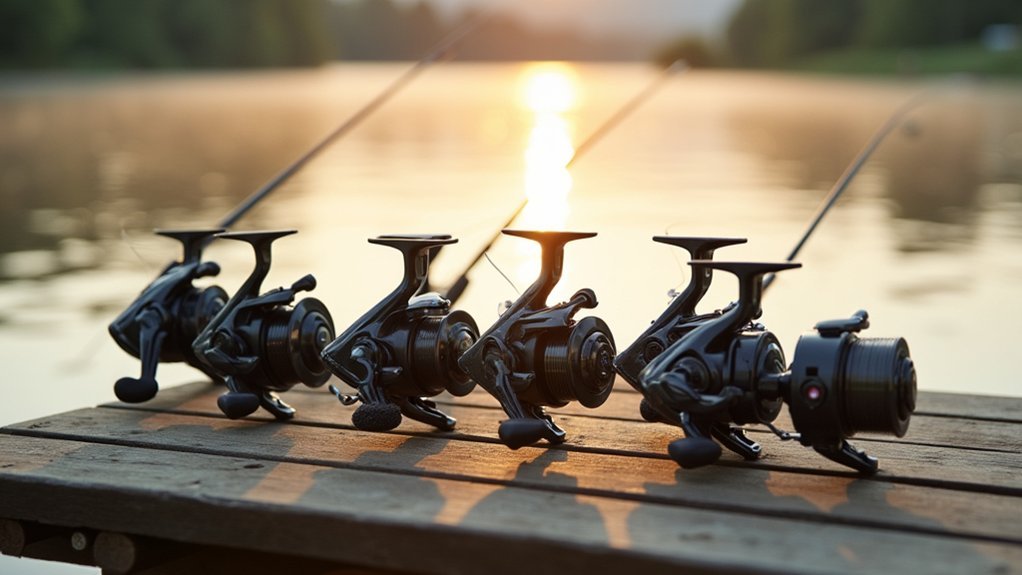



Leave a Reply